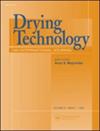Experimental study on condensate heat transfer coefficient of multi-channel cylinder dryer integrated with Bayesian-optimized machine learning prediction
IF 2.7
3区 工程技术
Q3 ENGINEERING, CHEMICAL
引用次数: 0
Abstract
Abstract The condensation heat transfer coefficient of the multi-channel dryer, one of the key component of paper-making machine, directly determines the efficiency of heat energy utilization. However, the prediction of condensation heat transfer coefficient remains a challenge because the heat transfer characteristics in multi-channel dryer is a complex fundamental issue involving the thermal behavior of two-phase fluid systems. Herein, we successfully developed the four supervised machine learning models to predict the heat transfer coefficient of a multi-channel cylinder dryer under different working conditions. The multi-channel cylinder dryer experiments under different steam mass flux and cooling water mass flow rates were performed and the measured data is used as the input data for training. Interestingly, the four trained Bayesian-optimized machine models present the excellent capability of prediction for condensation heat transfer coefficient of multi-channel cylinder dryer, where the values of R 2 for tested Bayesian-optimized-based SVR, ANN, linear SVR, and RF are 0.983, 0.997, 0.996, and 0.953, respectively. In addition, the feature importance of descriptors is quantified based on a random forest algorithm. Our study suggests that machine learning models can effectively predict the condensate heat transfer coefficient of two-phase fluid systems, which not only would be beneficial to optimizing the structures and operation parameters of multi-channel cylinder dryer in the industry but to develop a reasonable correlation of heat transfer coefficient in fundamental research.结合贝叶斯优化机器学习预测的多通道圆筒干燥机冷凝水换热系数实验研究
本文章由计算机程序翻译,如有差异,请以英文原文为准。
求助全文
约1分钟内获得全文
求助全文
来源期刊

Drying Technology
工程技术-工程:化工
CiteScore
7.40
自引率
15.20%
发文量
133
审稿时长
2 months
期刊介绍:
Drying Technology explores the science and technology, and the engineering aspects of drying, dewatering, and related topics.
Articles in this multi-disciplinary journal cover the following themes:
-Fundamental and applied aspects of dryers in diverse industrial sectors-
Mathematical modeling of drying and dryers-
Computer modeling of transport processes in multi-phase systems-
Material science aspects of drying-
Transport phenomena in porous media-
Design, scale-up, control and off-design analysis of dryers-
Energy, environmental, safety and techno-economic aspects-
Quality parameters in drying operations-
Pre- and post-drying operations-
Novel drying technologies.
This peer-reviewed journal provides an archival reference for scientists, engineers, and technologists in all industrial sectors and academia concerned with any aspect of thermal or nonthermal dehydration and allied operations.
 求助内容:
求助内容: 应助结果提醒方式:
应助结果提醒方式:


